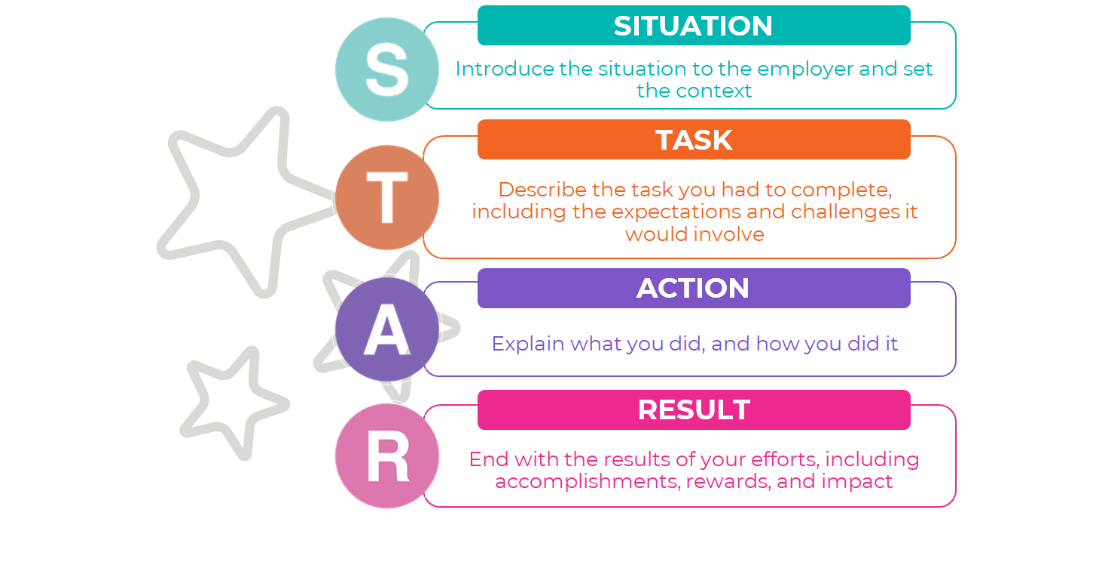Recognising the impact of negative thoughts
It is difficult in challenging times, such as interviews, to keep our thoughts full of confident messages. However, psychological research has shown that it is possible to improve self-belief by consciously challenging our thinking to be more positive, optimistic and constructive, which then influences our emotions and behaviour, towards being more self-assured in an interview situation.
Negative thoughts tend to just pop into our heads and can often be self-sabotaging; for example, ‘you will never get that job because...’, ‘you are not good enough...’. Often, we accept them as fact, and it does not occur to us to question them. However, Olson and Fazio (2002) found that these beliefs often reflect childhood learning and experiences: we internalise others’ judgements. They are only perceptions, not an accurate reflection of what is happening; an internal inner critic, constantly evaluating everything we do and perhaps stopping us gaining that long worked for career.
What self-limiting beliefs might you have about achieving interview success? What inner critic talk occurs when you don’t get a job you interviewed for (may feed into future interviews)?
Everyone has these negative thoughts: it is normally our inner voice trying to help us in some way. Therefore, rather than perhaps punishing yourself, try to recognise and acknowledge these thoughts, then work on replacing them with more positive thoughts to create an inner ally.
How could these negative thoughts be challenged? What could we say instead?
Learn more about reframing self-limiting beliefs here.
Achieving positive impact in the interview
There is much that can be done to be more positive and successful in an interview situation, and here are three areas to think about.
1: Nonverbal communication
Albert Mehrabian (1972) first proposed that only a small percentage of communication is words spoken (7%) and further studies have shown that 65% to 93% consist of nonverbal cues (e.g., Bonaccio et al., 2016). Therefore, vocal elements, such as tone, plus facial expressions, eye contact, attentiveness and posture have much more of an impact than we may consciously realise.
Moreover, nonverbal communication can influence interview outcomes, even if these are very discrete. For example, in their review of research on nonverbal communication in the workplace, Bonaccio et al. (2016) found that smiles, eye contact, expressiveness, hand gesturing, facial appearance and head nodding are all positively associated with interview success. Plus, Chaplin et al. (2000) found a firm, brief handshake can show sociability, friendliness and confidence. In contrast, keeping facial expressions neutral can unfortunately be interpreted as detachment or disinterest (Keating, 2006). So, nonverbal communication can draw the interviewer in (e.g., eye contact, smiling, head nodding) or push them away (e.g., frowning, no eye contact, neutral expression).
Consequently, nonverbal communication plays a significant role in what psychologists call impression management, where people use verbal and nonverbal tactics to influence and manage others’ favourable impressions of themselves (Bonaccio et al., 2016). Many employers now use structured and competency-based interviews (more on these below) to reduce the influence of impression management, as it may cause bias towards that person from the interviewer, even if may not be suitable for the role. However, Bonacci et al. (2016) suggest that unforced nonverbal communication is still a positive and successful impression management strategy, with verbal tactics being seen by employers as most manipulative.
Nonverbal communication can positively and confidently add to the words you use in an interview. Think especially about your posture and facial expressions, and how your thinking may contribute to these (see above). Make sure your body and face are saying what you want them to! Lastly, tone of voice will also communicate your emotions; however, work on feelings and tone will follow, or you may sound fake!
If possible, practice interview nonverbal communication with a close colleague or friend, or even in front of a mirror – you may be surprised by what you unconsciously communicate! However, remember to also just be yourself (don’t go overboard, as this may come across as false and manipulative!).
2: Power in interviews
Another aspect of interviews is the influence of power: who we (consciously or unconsciously) feel is in control and how that affects our confidence; in a stressful interview situation we could feel relatively powerless in relation to the interviewer. Here, body language could help, as this not only affects how others see us, but can influence how we see ourselves. Research by Cuddy et al. (2015) found that when people feel less confident, they may stand hunched, with arms folded and head lowered (low-power pose); however, people who want to demonstrate power and confidence stretch out, standing straight with broad chest, and perhaps hands on hips (high-power pose).
Bonacci et al.’s (2016) review found that high-power poses can improve feelings of being in control, confidence and self-esteem, and Cuddy et al. (2015) demonstrate that, compared to low-power posers, high-power posers appear more composed and confident, plus more captivating and enthusiastic, leading to higher overall performance evaluations. Furthermore, Smith et al. (2008) found that power posing improves cognitive function.
However, don’t worry, high-power poses are not done in the interview! Cuddy et al. (2015) suggest doing these before a stressful event, such as an interview, is just as effective. And being aware of low-power body language within the interview may also help. Amy Cuddy explains power posing further below:
3: Competency-based interview questions
Interviews are now commonly structured around competency-based questions: skills, attitudes and behaviours required for the specific job. This helps to prevent any bias by the interviewer by asking each candidate the same questions. They tend to start with a variation of: ‘Describe a situation when...’, ‘Give an example of...’ and may sound quite simple to answer. However, under pressure, it is easy to give an unstructured answer that misses out key details or is over long, which could cost you the job! Preparing answers and practicing will not only demonstrate required competencies to the interviewer but feeds you with confidence that you are the best person for the job.
First, it is important to know what skills, attitudes and behaviours are required. These can be found in the job advert and/or job description. Secondly, it is essential to learn about the organisation's overall requirements for employees, which can often be found on their website, titled ‘core competencies’ or ‘values.’ Once familiar with both, ‘STAR’ is especially useful for structuring and practicing responses to competency-based questions.

As an example, here is possible interview question for a customer services role, with a STAR structured response:
"Describe a situation when you had to provide excellent customer service following a complaint"
- Situation: "A customer rang to complain they'd waited more than a week for a reply about a missing part from a product they’d ordered."
- Task: "I first needed to address the customer’s immediate complaint and then find out what went wrong to resolve the situation."
- Action: "I apologised and reassured the customer they would be rung back within the hour with a resolution. I investigated why the complaint was not answered and discovered we had been ringing an incorrect phone number. I let the client know that the missing part had now been dispatched and offered a goodwill discount on her order."
- Result: "The customer was very pleased, placing a further order and posting a positive comment on our social media page."
Speaking in specific, rather than general, terms and finishing on a positive note, makes the story interesting and clearly demonstrates your abilities, as well as keeping your answers concise (as there may be a few questions). The actual STAR structure is invisible to the interviewer - it simply comes across as a well-articulated example that conveys your ability to do the job.
With a trusted colleague or friend, try to think of questions you might be asked about the specific job and organisation’s competencies, then write out and practice using STAR for each one.
Other help for success in interviews
There is quite a lot to think about in this article, but in a nutshell:
- watch your thinking, does it need challenging?
- remember how important your non-verbal behaviour is, does this change under pressure?
- think about how to stand to give you confidence, and how to sit in the interview to avoid low-power body language
- prepare and practice some STAR answers
Always remember that some nerves are good, as they cause adrenaline to keep you focused and perform at your best, and always just be yourself!
There are also further resources you may find useful in the Applying Psychology at Work Hub:
Including:


Rate and Review
Rate this article
Review this article
Log into OpenLearn to leave reviews and join in the conversation.
Article reviews